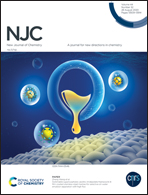Thermally healable polyurethane with tailored mechanical performance using dynamic crosslinking motifs†
Abstract
Materials with self-healing abilities have gained tremendous attention in recent years but combing excellent mechanical performance and splendid self-healing capacity into a single polymer material is still a great challenge. In this study, a self-healing polyurethane (SHP) material was prepared by constructing a dynamic cross-linked network via quadruple hydrogen bonds formed from 5-(2-hydroxyethyl)-6-methyl-2-aminouracil (UPy). The mechanical properties of the materials could be conveniently tuned by adjusting the dynamic cross-linked density. The optimal sample, SHP-75, has excellent mechanical performance, showing high tensile strength (27.02 MPa), excellent stretchability (1300%), and prominent toughness (111.37 MJ m−3). Despite such great mechanical properties, SHP-75 exhibited superior self-healing abilities and could fully obtain its initial mechanical strength after repairing at 80 °C for 24 h. A self-healing conductive electrode was further constructed to demonstrate its application prospects in the field of sensing.



 Please wait while we load your content...
Please wait while we load your content...